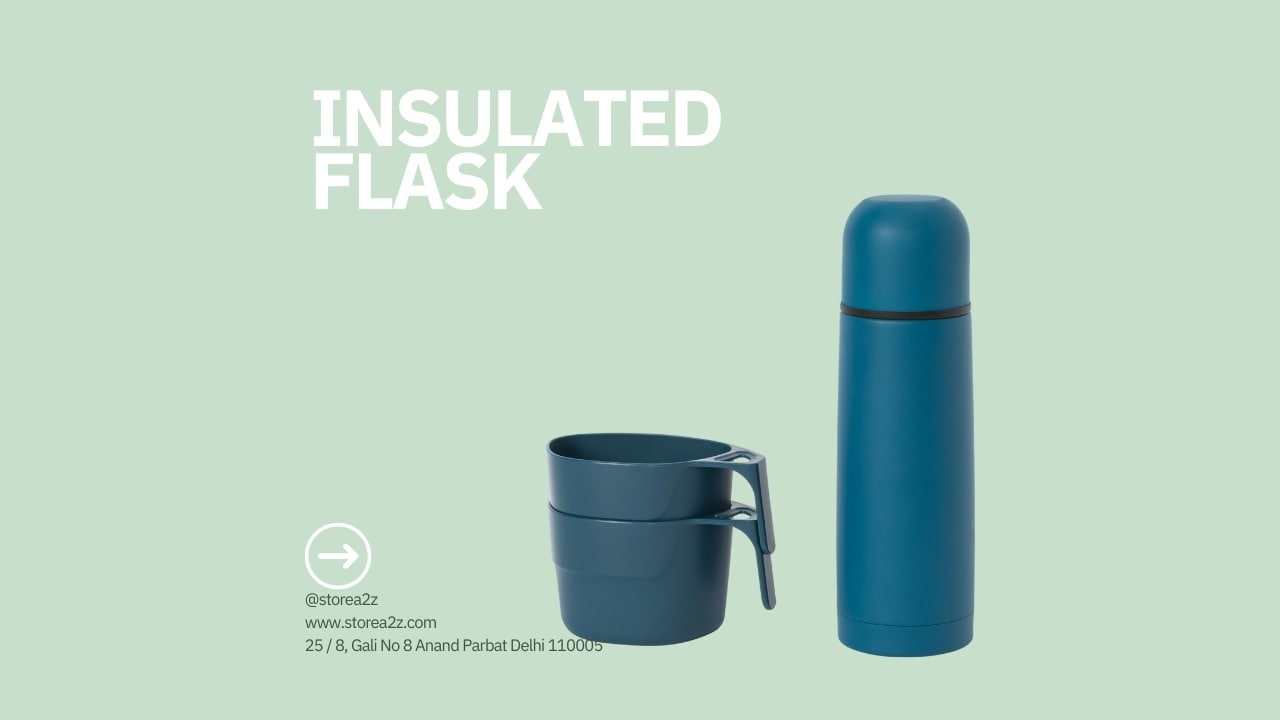Whether you’re commuting to the office, hitting the gym, or heading out on a weekend trip, a well-chosen insulated flask can be your trusted companion—keeping drinks piping hot or refreshingly cold. But with so many options available, how do you pick the one that fits your lifestyle? In this post we’ll walk you through the key factors to consider when selecting an insulated flask, so you can shop confidently at StoreA2Z and choose the right model for your needs.
Understand the Basics: What makes an insulated flask work?
At its core, an insulated flask works by reducing heat transfer between the liquid inside and the outside environment. Many models feature double-wall vacuum construction (a gap between two walls with no air) which dramatically slows down heat loss or gain.
What this means for you: When shopping for an insulated flask, look for clear claims of heat retention (e.g., “12 hours hot / 24 hours cold”) and construction details like “double-wall” or “vacuum insulated”.
Material Quality: Stainless Steel, Vacuum Layers & Lid Design
Material matters. A high-quality insulated flask should use food-grade stainless steel (often labelled 18/8 or 304 stainless) for the inner and outer walls. One guide notes that cheaper flasks use lower-grade steel or plastic components, which can affect durability and safety.
Also important: the lid or cap. A flask may promise great insulation, but if the lid leaks heat (or leaks liquid), you’re losing performance. Research shows that the mouth diameter and lid seal help determine how well a flask works.
So when you browse StoreA2Z’s insulated flask collection, check:
- Is it labelled vacuum or double-wall insulated?
- What grade of stainless steel is used?
- How is the lid sealed (threaded screw, push-button, flip-cap)?
- Are there any leak-proof or pressure-release features?
Size & Capacity: Match It to Your Routine
One of the most overlooked aspects is picking the right capacity and form factor for your lifestyle. Do you carry your flask to work and want something compact? Do you take long trips and need a larger volume? Some guides suggest lightweight flasks (~0.35 kg) are easier when you’re moving around.
Here are a few considerations:
- Everyday use: 500-750 ml is often enough for most people.
- Travel or long day out: 1 L or more may be useful.
- Fit in bag or car cup-holder? Narrower profiles fit better.
- Portability vs insulation: Larger flasks hold more but weigh more and may be harder to carry.
Hot vs Cold Performance: What You Need
While many flasks claim both hot and cold retention, it helps to check the specifics. For hot beverages, you want good heat retention so your drink stays hot for hours. For cold drinks, you want minimal warm-up and reduced condensation on the outside of the flask.
Some tips:
- Look for explicit durations (e.g., “12 hours hot / 24 hours cold”).
- A narrower mouth often retains heat better because less surface area is exposed.
- For cold use, sealing and lid design are just as important to prevent warming and sweat.
Portability, Ergonomics & Design Features
Even the best insulated flask will disappoint if it’s awkward to carry or use. Here are design features to check:
- Handle or carrying loop: Especially useful if you travel.
- Shape and profile: Will it fit into your bag, cup holder or backpack side pocket?
- Lid usability: Is it easy to open with one hand? Does it leak when tipped?
- Aesthetics: If you carry it daily, you’ll want something you like to look at.
Remember: Practical usability matters as much as insulation specs.
Cleaning, Maintenance & Durability
Good performance must last, and that means cleaning and durability matter. Stainless steel flasks are generally durable, but lids, seals, and threads are points of failure. According to product-check guides:
- Inspect packaging and markings (manufacturer, standard, food-contact use) when buying.
- Make sure plastic parts are minimal or food-safe.
- A flask that is easy to clean will last longer and maintain taste.
Budget & Value: Don’t Overpay for Gimmicks
Finally, think about value. A premium insulated flask may cost more, but if it delivers strong heat/cold retention, durable materials, and trustworthy brand backing, it may be worth it. Before you buy:
- Compare insulation claims vs real-world use (reviews).
- Check warranty or brand support.
- Balance size and performance with your actual need.
Conclusion
Choosing the right insulated flask is more than just picking the one with the fanciest color. It’s about matching your needs with quality materials, reliable insulation, smart design, and value. As you browse the selection at StoreA2Z, keep in mind these key factors: material & lid quality, capacity, hot/cold performance, portability, cleaning ease, and overall value.
Whether you’re sipping hot coffee on a chilly morning or staying hydrated with iced water through a long day, the right flask makes a big difference. Take your time, use these guidelines, and you’ll find the one that fits your lifestyle perfectly.
How to Choose the Best Insulated Flask for Hot and Cold Beverages
Whether you’re commuting to the office, hitting the gym, or heading out on a weekend trip, a well-chosen insulated flask can be your trusted companion—keeping drinks piping hot or refreshingly cold. But with so many options available, how do you pick the one that fits your lifestyle? In this post we’ll walk you through the key factors to consider when selecting an insulated flask, so you can shop confidently at StoreA2Z and choose the right model for your needs.
Understand the Basics: What makes an insulated flask work?
At its core, an insulated flask works by reducing heat transfer between the liquid inside and the outside environment. Many models feature double-wall vacuum construction (a gap between two walls with no air) which dramatically slows down heat loss or gain.
What this means for you: When shopping for an insulated flask, look for clear claims of heat retention (e.g., “12 hours hot / 24 hours cold”) and construction details like “double-wall” or “vacuum insulated”.
Material Quality: Stainless Steel, Vacuum Layers & Lid Design
Material matters. A high-quality insulated flask should use food-grade stainless steel (often labelled 18/8 or 304 stainless) for the inner and outer walls. One guide notes that cheaper flasks use lower-grade steel or plastic components, which can affect durability and safety.
Also important: the lid or cap. A flask may promise great insulation, but if the lid leaks heat (or leaks liquid), you’re losing performance. Research shows that the mouth diameter and lid seal help determine how well a flask works.
So when you browse StoreA2Z’s insulated flask collection, check:
- Is it labelled vacuum or double-wall insulated?
- What grade of stainless steel is used?
- How is the lid sealed (threaded screw, push-button, flip-cap)?
- Are there any leak-proof or pressure-release features?
Size & Capacity: Match It to Your Routine
One of the most overlooked aspects is picking the right capacity and form factor for your lifestyle. Do you carry your flask to work and want something compact? Do you take long trips and need a larger volume? Some guides suggest lightweight flasks (~0.35 kg) are easier when you’re moving around.
Here are a few considerations:
- Everyday use: 500-750 ml is often enough for most people.
- Travel or long day out: 1 L or more may be useful.
- Fit in bag or car cup-holder? Narrower profiles fit better.
- Portability vs insulation: Larger flasks hold more but weigh more and may be harder to carry.
Hot vs Cold Performance: What You Need
While many flasks claim both hot and cold retention, it helps to check the specifics. For hot beverages, you want good heat retention so your drink stays hot for hours. For cold drinks, you want minimal warm-up and reduced condensation on the outside of the flask.
Some tips:
- Look for explicit durations (e.g., “12 hours hot / 24 hours cold”).
- A narrower mouth often retains heat better because less surface area is exposed.
- For cold use, sealing and lid design are just as important to prevent warming and sweat.
Portability, Ergonomics & Design Features
Even the best insulated flask will disappoint if it’s awkward to carry or use. Here are design features to check:
- Handle or carrying loop: Especially useful if you travel.
- Shape and profile: Will it fit into your bag, cup holder or backpack side pocket?
- Lid usability: Is it easy to open with one hand? Does it leak when tipped?
- Aesthetics: If you carry it daily, you’ll want something you like to look at.
Remember: Practical usability matters as much as insulation specs.
Cleaning, Maintenance & Durability
Good performance must last, and that means cleaning and durability matter. Stainless steel flasks are generally durable, but lids, seals, and threads are points of failure. According to product-check guides:
- Inspect packaging and markings (manufacturer, standard, food-contact use) when buying.
- Make sure plastic parts are minimal or food-safe.
- A flask that is easy to clean will last longer and maintain taste.
Budget & Value: Don’t Overpay for Gimmicks
Finally, think about value. A premium insulated flask may cost more, but if it delivers strong heat/cold retention, durable materials, and trustworthy brand backing, it may be worth it. Before you buy:
- Compare insulation claims vs real-world use (reviews).
- Check warranty or brand support.
- Balance size and performance with your actual need.
Conclusion
Choosing the right insulated flask is more than just picking the one with the fanciest color. It’s about matching your needs with quality materials, reliable insulation, smart design, and value. As you browse the selection at StoreA2Z, keep in mind these key factors: material & lid quality, capacity, hot/cold performance, portability, cleaning ease, and overall value.
Whether you’re sipping hot coffee on a chilly morning or staying hydrated with iced water through a long day, the right flask makes a big difference. Take your time, use these guidelines, and you’ll find the one that fits your lifestyle perfectly.


